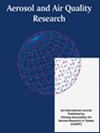Characterisation of the Aerodynamic Aerosol Classifier Transfer Function for Particle Sizes up to 5 Micrometres
IF 2.5
4区 环境科学与生态学
Q3 ENVIRONMENTAL SCIENCES
引用次数: 0
Abstract
The Aerodynamic Aerosol Classifier (AAC) classifies particles with the desired aerodynamic diameter by generating opposing centrifugal and drag forces on the particles using rotating concentric cylinders and a clean sheath flow. Particle transmission through the classifier is described by its transfer function, which is an important indicator of classifier performance. Characterisation of the classifier’s transfer function improves the accuracy of its common aerosol applications, such as measuring particle size distributions or providing classified particles to other aerosol instruments for calibration or further analysis. This characterisation is commonly achieved experimentally using a tandem set-up of the same classifier. While this approach was previously used to characterise the AAC’s transfer function for particle aerodynamic diameters up to 2.4 µ m using a nebuliser and a Condensation Particle Counter (CPC), the current study expands the AAC’s characterisation up to 5 µ m using a condensation aerosol generator and an Optical Particle Counter (OPC). This upper size range is significantly higher than that offered by other common aerosol classifiers, such as the approximate 1 µ m upper limit typical of the Differential Mobility Analyser (DMA), and it is well suited to many applications, including OPC calibration, bio-aerosols, drug delivery and inhalation studies, and atmospheric dust analysis. This study found that the AAC maintains its high transmission efficiency ( ≥ 60%) for particles up to 5 µ m and that its transfer function width factor increases (i.e., the distribution becomes narrower) as the aerodynamic diameter increases. Setpoint agreement between two different production AACs remained within 2% over the size range tested. Therefore, the AAC has excellent performance for classifying particles up to 5 µ m.表征的空气动力学气溶胶分类传递函数的颗粒尺寸高达5微米
空气动力气溶胶分类器(AAC)利用旋转的同心圆柱体和干净的护套流对颗粒产生相反的离心力和阻力,从而对具有所需空气动力直径的颗粒进行分类。颗粒通过分类器的传递函数是描述其传递特性的重要指标。分类器传递函数的特性提高了其常见气溶胶应用的准确性,例如测量粒径分布或为其他气溶胶仪器提供分类颗粒进行校准或进一步分析。这种表征通常是通过使用同一分类器的串联设置来实现的。虽然这种方法以前被用来表征AAC的传递函数的粒子气动直径高达2.4 μ m,使用雾化器和冷凝粒子计数器(CPC),目前的研究扩大了AAC的表征高达5 μ m,使用冷凝气溶胶发生器和光学粒子计数器(OPC)。该上限尺寸范围明显高于其他常见气溶胶分类器提供的上限,例如差分迁移率分析仪(DMA)的典型上限约为1 μ m,并且非常适合许多应用,包括OPC校准,生物气溶胶,药物输送和吸入研究以及大气粉尘分析。本研究发现,对于5µm以下的颗粒,AAC仍能保持较高的透射效率(≥60%),且随着气动直径的增大,其传递函数宽度因子增大(即分布变窄)。两种不同生产aac之间的设定值一致性在测试的尺寸范围内保持在2%以内。因此,AAC对5µm以下的颗粒具有优异的分类性能。
本文章由计算机程序翻译,如有差异,请以英文原文为准。
求助全文
约1分钟内获得全文
求助全文
来源期刊

Aerosol and Air Quality Research
ENVIRONMENTAL SCIENCES-
CiteScore
8.30
自引率
10.00%
发文量
163
审稿时长
3 months
期刊介绍:
The international journal of Aerosol and Air Quality Research (AAQR) covers all aspects of aerosol science and technology, atmospheric science and air quality related issues. It encompasses a multi-disciplinary field, including:
- Aerosol, air quality, atmospheric chemistry and global change;
- Air toxics (hazardous air pollutants (HAPs), persistent organic pollutants (POPs)) - Sources, control, transport and fate, human exposure;
- Nanoparticle and nanotechnology;
- Sources, combustion, thermal decomposition, emission, properties, behavior, formation, transport, deposition, measurement and analysis;
- Effects on the environments;
- Air quality and human health;
- Bioaerosols;
- Indoor air quality;
- Energy and air pollution;
- Pollution control technologies;
- Invention and improvement of sampling instruments and technologies;
- Optical/radiative properties and remote sensing;
- Carbon dioxide emission, capture, storage and utilization; novel methods for the reduction of carbon dioxide emission;
- Other topics related to aerosol and air quality.
 求助内容:
求助内容: 应助结果提醒方式:
应助结果提醒方式:


